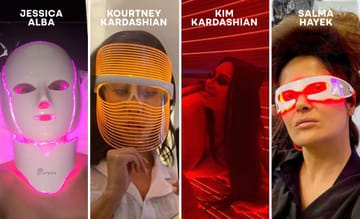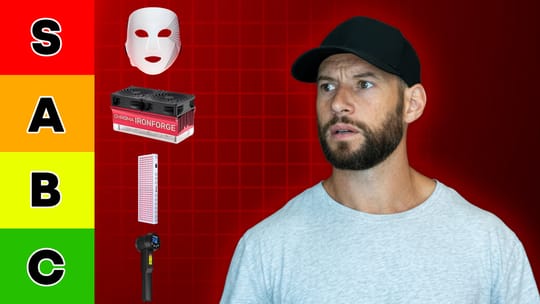In this blog I talk about red light therapy contraindications. Or in plain English, there are some "red light therapy dangers" that you should know about. These dangers are extremely rare though, but you'll still need to know about them to give yourself red light therapy as effectively as possible.
I'll first talk about risk of red light therapy in general and then consider some general red light therapy contraindications, as well as anecdotal evidence. Lastly, I tell you who should use red light therapy and and who shouldn't.
How Risky Is Red Light Therapy In General?
Overall, red light therapy is extremely safe (1; 2; 3; 4; 5). There are only a few cases where the safety of red light therapy is debated, such as in case of active cancers.
I'll consider all the cases where there's potential safety issues in the next section below. Suffice it to say that there's now a five-decade long track record of using red light therapy (or "photobiomodulation" as it's called in science) for many different health conditions. Millions of people have used red light therapy with both lasers and LEDs over the course of decades.
James Carroll, one of the people who has decades worth of experience in the red light therapy industry, has also used full-body red light therapy for decades now. And, he's not just drawing on his own experience - he's got an extensive clientele who have all used full body red light therapy for many years now.
These people using full-body red light therapy don't have any red light therapy side effects. Instead, the results of red light therapy accumulate over time. With red light therapy, you can train your body more frequently, for instance, because you recover much more quickly. In turn, you can boost the health effects that you get from exercise massively.
Also, red light therapy does an excellent job of managing systemic inflammation, which tends to trend up over time as humans age. Lower levels of systemic inflammation, in turn, lead to higher energy production in your body.
And that higher energy production, in turn, is very beneficial for countering almost any disease, as the argument can be made that energy production and mitochondrial health lay at the basis of most health and disease in general (6; 7; 8; 9; 10; 11).
Basically, energy production goes down as you age because the DNA of your mitochondria attains genetic mutations. But, red light therapy can keep your mitochondria - the "energy-producing factories of your cells" working more efficiently - therefore counting your overall disease risk (12; 13; 14; 15; 16). Different mechanisms exist for that effect.
Overall, few people have side effects from red light therapy. And, the long-term side effects of red light therapy are extremely rare. Nevertheless I do want to talk about each and ever red light therapy contraindication in detail - no matter how small the risk - so that you're fully informed:
Evident Contraindictions for Red Light Therapy
Below I'll talk about all the evidence contraindications of red light therapy. Such contraindications may have evidence behind them in the medical literature, or may just be plausible biological mechanisms that haven't been demonstrated yet but still occur when people use red light therapy.
Let's go over many of these contraindications one by one:
Can Red Light Therapy Cause Cancer?
First up, something many people routinely ask: "Can red light therapy cause cancer?"
The answer here is complex. I'll summarize the available research here (17; 18; 19; 20; 21; 22; 23; 24). First up, there's this extremely important statement in that red light therapy is used to manage the toxicity of cancer treatments. Researchers write:
"Most studies showed that no side effects were observed with the use of [red light therapy]. The results of this systematic review, based on current literature, suggest that the use of [red light therapy] in the prevention and management of cancer treatment toxicities does not lead to the development of tumor safety issues." (17).
Next up, with regard to red light therapy and cancer, there's this statement:
"Although there are a few articles suggesting that [red light] therapy can be detrimental in animal models of tumors, there are also many articles that suggest the opposite and that light can directly damage the tumor, can potentiate other cancer therapies, and can stimulate the host immune system. Moreover, there are two clinical trials showing increased survival in cancer patients who received [red light] therapy."
So red light therapy isn't unsafe for cancer. And, in some studies red light therapy is even helpful for countering cancer. But, there's no solid 100% safety profile to be found in the current literature. For that reason I recommend talking to your physician if you've got any active cancer.
Often, there are three main recommendations I have if there's an active cancer:
- Talk to your physician about whether you can use red light therapy in the first place. Only with a green light of your physician can you proceed with red light therapy treatments.
- Make sure the cancerous area is contained and you don't have any metastazations, or the risk thereof. If cancer has spread throughout your body or has the risk of spreading, don't use red light therapy.
- Cover up the cancerous area so that it doesn't receive any light. A thicker towel that's darker in color (absorbs more light) is the best to prevent any light from penetrating. If you wish to learn more about how different fabrics block light from penetrating, check Alex's experiment on using different fabrics to block light.
I hope that's very clear! Don't take any unnecessary risk until the science on red light therapy and cancer is progressed a lot more in the coming decades. That progress in science should tell us more exactly when and how to use red light therapy with cancer and when not.
Is Red Light Therapy Safe For Cancer Patients?
Again, red light therapy has huge potential to deal with the side effects of cancer treatments. But, in absence of clinical judgement by a physician I'm not willing to put out a universal recommendation out there because such a recommendation will certainly lead to a deteriorating situation in some people.
Despite my conservative recommendation, I also want to emphasize that the potential of red light therapy for countering cancer treatment side-effects is huge. Researchers write:
"There is a large body of evidence demonstrating the efficacy of [red light therapy] for preventing [oral mucositis] in certain cancer patient populations [...]. [There's evidence for red light therapy] treatment parameters for prophylactic and therapeutic use in supportive care for radiodermatitis, dysphagia, xerostomia, dysgeusia, trismus, mucosal and bone necrosis, lymphedema, hand-foot syndrome, alopecia, oral and dermatologic chronic graft-versus-host disease, voice/speech alterations, peripheral neuropathy, and late fibrosis amongst cancer survivors." (21).
So that's good news! Future research only needs to tell us when to apply red light therapy and when not - and the expected results.
Long-Term Effects Of Red Light Therapy: What We Know
As stated before, the long-term effects of red light therapy are extremely promising. Most people using red light therapy don't just have temporary beneficial effects, but long-term results that keep getting better over age.
James Carroll, for instance, who has been using red light therapy for decades brags about how his doctor cannot believe how few gray hairs he has even though he's in his 60s, and how his recovery from workouts is amazing and his physical performance can still increase at that ripe age.
Also, many people like I and Alex Fergus have been using full body red light therapy with LED panels for almost a decade now. And our responde reflects that of James Carroll - we've got better recovery in our 30s than we had in our 20s, and very intense workouts lead to lighting fast recovery. Also, we've got better hair growth than in our 20s and seem to do way better than many of our age-related peers.
If you wish to learn about some of the long-term effects of red light therapy, check out these videos:
How Alex Fergus lost his benefits after quitting red light therapy for four weeks
Alex describes how he lost out on his oral health benefits while not using red light therapy for a while
What Are The Side Effects Of Red Light Therapy?
Here are some potential cases in which there can be side effects of red light therapy:
Epilepsy (Due To Pulsing And Flicker)
Red light therapy can be extremely helpful in epilepsy (29; 30; 31). Recent studies on red light therapy for epilepsy are very promising.
However, in some cases, if you're susceptible to epilepsy, you'll have to be careful with red light therapy. You'll specifically want a "flicker-free" red light therapy panel and want to be careful with the red light therapy pulsing options.
Pulsing means that within a second, the light will turn on and off quickly. So a 20 Hz pulse means that the light turns on and off 20 times per second. Those pulses might trigger epilepsy in some, so I'd be extra careful in these cases.
Eye Health (Long-Term - With Overdosing)
Red light therapy has extremely promising effects for many eye diseases (32; 33; 34; 35; 36; 37).
The issue here is the correct dosing. You'll want the correct dosing if you're treating your eyes. And, for many different eye conditions that optimal dose will vary.
The problem potentially starts when you've got a very high-powered red light therapy panel that has an output of say 70 or 80 mW/cm2. In that case I'd be careful exposing your eyes directly to the red and near-infrared light, even though red light therapy is helpful for eye diseases across the board.
If you'd like to learn more, read my article about red light therapy
Illness - With A Very Active Immune System
So red light therapy is a so-called "hormetic stressor". Hormetic stress entails that it's a stimulus that puts an organism under temporary stressor, which can make the organism stronger over time.
Exercise and cold therapy are two examples of hormetic stressors. But, if you're weak due to an active illness, such as a viral or bacterial infection, or for another reason, you may want to take the red light therapy slow.
Also, if you're chronically ill, you'll probably have to take things very slow in the beginning. So if you've got chronic fatigue, diabetes, and another chronic health condition, you probably cannot handle red light therapy as a normal person does.
Hence, you'll have to keep the dosage lower by standing further away from the panel or by reducing the treatment time.
Medication That Created Light Hypersensitivity
Some types of medication create light hypersensitivity. Mostly, that hypersensitivity exists towards ultraviolet light - not red and infrared light - but I'll mention this problem anyway just in case (38; 39; 40; 41).
I can't name every medication on the planet here. Instead, I recommend checking the safety profile of any medication you may be taking and observing where there's any light-drug interaction, even if it's just a topical drug.
Different Dosing Due To Skin Type
A few studies show that people with very dark skin respond differently to red light therapy and may absorb more red and near-infrared light per session (42; 43). So with a very dark skin you may need to lower your dosage per session.
Long-Term Mitochondrial And Other Effects
So there's another issue with the long-term effects of red light therapy. Currently, science doesn't really know what happens when you chronically overstimulate certain pathways such as "Cytochrome C Oxidase", the terminal step in the energy-creation process in the mitochondria.
With red light therapy, you can supply your body with a lot higher doses of light at certain wavelengths such as 630nm, 660nm, 810nm, and so forth. In theory, there may be effects of that overstimulation that haven't been found by the current science yet, but, which give rise to side effects decades down the road.
I will say here that the experience of James Carroll who has decades worth of experience with full body red light therapy for him and his clients directly contradicts this thesis. But I wanted to mention this potential side effect for completeness' sake anyway.
Brain Health And Brain Disease: Dr Randy Beck's Argument
So here's an argument you need to now about when thinking about potential red light therapy side effects for the brain. Our very own Alex Fergus interviewed Dr Randy Beck about using red light therapy for the brain in the interview below:
Whether you agree with Dr Beck's argument or not, it's very important to hear. Dr Beck's argument is that if you've got a brain condition, such as after a stroke or if you've got epilepsy, it's mandatory to do some quantification first on your brain to predict better how your brain is going to respond to red light therapy.
The problem here is that with serious brain conditions, red light therapy can make things better or worse. Without some testing, whether you get better or worse is far more unpredictable. Hence, Dr Beck uses QEEG or "Quantitative Electro-Encephalo-Graphy" to get a better predictive model of what brain areas need stimulation and which brain areas arguably do worse if they're stimulated even more.
I personally think this argument is great if you've got a brain condition. If not, then I think you can be more liberal with applying red light therapy to the brain, in normal doses. The reason for this conclusion is that if every person needed a QEEG before applying red light therapy to the brain, they'd need to avoid the sunlight consistently too because it emits 40 mW/cm2 of near-infrared to the brain when you're outside. And, that conclusion doesn't make sense, so for people with a healthy brain I don't think there's a problem here.
Anecdotal Contraindications For Red Light Therapy
There's also some anecdotal evidence on the contraindications for red light therapy. I can't always extensively support these with research, but we've found many of these effects in our Facebook group:
Hyperthyroidism
Quite a few studies show that red light therapy can improve thyroid health, especially autoimmune conditions of the thyroid (whereby the immune system attacks your own tissues) and hypothyroidism (25; 26; 27; 28).
Theoretically, although this hasn't been shows in any studies, you could end up with a too-quick thyroid if a normal thyroid is "sped up" (although this is an oversimplified vision).
Skin Rashes Or Feeling A "Sunburn"
Some people get skin rashes, rarely. And others get a "sunburn" feeling sensation, which isn't a real sunburn as there's no ultraviolet light involved.
Fatigue
You can feel more tired after a red light therapy session. In such a case, you've overdone it.
Here, there is a dose-response relationship because red light therapy is a hormetic stressor (29; 30; 31). In case you've got any chronic health conditions, you may want to slow down your exposure to red light therapy and start really slowly.
So, if you've got diabetes and heart disease and chronic fatigue, you may not be able to do a full normal red light therapy session.
Other Potential Side Effects
Here are a few potential side effects:
- Red light therapy weight loss side effects - red light therapy boosts fat loss, and sometimes this can cause fat loss in the face because you're getting leaner. There's no evidence right now that any particular wavelength causes fat loss in the face though.
- Red light therapy rash side effect - Sometimes people get a rash or an itch.
- Side effects of red light therapy on face - sometimes people still report side effects on the face. This evidence is anecdotal, however, as many red light therapy products have excellent results for facial appearance and beauty! Read my skin and beauty effects blog to learn more.
- Red light therapy nausea - again, this is only anecdotal and if you feel nausea, you need to cut down on red light therapy, plain and simple!
So, Who Should Not Use Red Light Therapy - Only People With Cancer
As stated before, in case of cancer should you really not use red light therapy. Talk to your doctor first before applying it.
Like I said earlier, there's been quite a lot of research on red light therapy for cancer (32; 33; 34; 35; 36). For now, I certainly recommend avoiding applying red light therapy to any cancerous area. Also, I recommend covering up an area afffected by cancer at the bare minimum.
Red light therapy can also work really well with cancer side effects, such as oral mucositis. But once more, I recommend talking to your doctor first.
Other people who should not use red light therapy are people who get random side effects whereby the benefits don't outweigh the downsides. Also, if you get any of the side effects I've described above, it's good to re-evaluate.
Conclusion: The Red Light Therapy Contraindications Are Simple
I've hopefully provided a list of the red light therapy contraindications. Nevertheless, always observe the results you're getting and listen to your body. If you're getting poor results or have side effects - for whatever reason - change your dosing protocol!
Frequently Asked Questions
In the section below, I'll answer a few assorted questions that many people ask about potential red light therapy side effects:
Can Red Light Therapy Cause Skin Cancer?
Red light therapy almost certainly doesn't cause skin cancer. Even in the case of ultraviolet light exposure - unless you overdo it - I don't even think there's a link there!
Can Red Light Therapy Cause Migraines?
In some rare cases, red light therapy can cause migraines or headaches. Slowing down with your sessions, such as less treatement or using the product from a longer distance, are solutions then.
Why Does Red Light Hurt My Eyes?
You may be overexposing yourself to the red light. Or you may simply not be used to any intense light sources. Some people need to build up their tolerance to strong light, because they're never outside in the sun, for instance. Other people need to lower the intensity, because they're using light that's too bright for too long. Check my eye health article if you want more info.
Should Diabetics Avoid Light Therapy?
No, with recent research on red light therapy lowering blood sugar levels, diabetics will likely do very well with red light therapy. And red light therapy deals with many of the underlying causes of diabetes, such as
How Can I Make Sure Led Light Therapy Is Right for Me?
Follow the dosing protocols of the company that has send you the product, is the easiest answer here. Also, buy a high-quality product. Most people are helped by red light therapy, but if you're not sure, read about the red light therapy benefits.
What About Blue Light Therapy Side Effects?
Blue light therapy can cause eye problems, when you're overexposed, and potentially have effects mediated through the skin. Blue light therapy has benefits too - check my blog on the topic!
How About Green Light Therapy Side Effects?
Green light therapy doesn't have any known side effects, but it's not studied very well either. So be careful with super high doses, because of unkowns, but generally you should be safe!
Found This Interesting? Then You Might Like:
- Start Here - Light Therapy 101 & Buyers Guide
- Discount Codes, Deals & Recommendations - Red Light Therapy
- Red Light Therapy For Upgrading Your Brain Health
- Red Light Therapy For Weight Loss: The Science Of Supercharging Fat Loss
- Red Light Therapy For Sleep: The Science of Sweet Dreams
- The Effectiveness Of Light Therapy For Sleep Disorders
This is a post by Bart Wolbers of Lighttherapyinsiders. Bart finished degrees in Physical Therapy (B), Philosophy (BA and MA), Philosophy of Science and Technology (MS - with distinction), and Clinical Health Science (MS), has had training in functional medicine, and is currently chief science writer.









